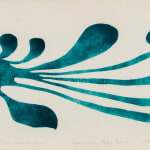-
Artworks
KENOJUAK ASHEVAK, C.C., R.C.A. (1927-2013) KINNGAIT (CAPE DORSET)
Rabbit Eating Seaweed, 1958 (1959 #8)Printmaker: IYOLA KINGWATSIAK (1933-2000) KINNGAIT (CAPE DORSET)
sealskin stencil, 8.75 x 24 in (22 x 61 cm), irregular
4/30Lot 87
ESTIMATE: $40,000 — $60,000
PRICE REALIZED: $72,000.00In his first memoir, James Houston recalls seeing Kenojuak Ashevak on the beach, carrying a bag. The sealskin bag was of her own design and creation and featured contrasting sealskin...In his first memoir, James Houston recalls seeing Kenojuak Ashevak on the beach, carrying a bag. The sealskin bag was of her own design and creation and featured contrasting sealskin designs. When she was asked what the design represented, she replied, “Rabbit thinking of eating seaweed”. [1] While she was already the first woman that Houston asked to make drawings as part of the new graphic arts program in Cape Dorset, this bag provided the ensuing print’s design with no preparatory drawings needed. The printmaker Iyola Kingwatsiak enlarged the bag’s design on paper and cut the sealskin stencil to create this now iconic print from the first annual collection. Both the rabbit (an Arctic hare) and the seaweed fronds are sensitively stenciled in a mottled blue ink tinged with deeper shades along the rabbit’s ears and lower body and the outer tips of the fronds.
Rabbit Eating Seaweed has a sense of magic and mystery that would flow throughout Kenojuak’s long career but is particularly evident in her early prints for the annual collections. To our thinking the meaning of this image is not as straightforward as its title would suggest. The rabbit, delightfully rotund, apparently munches away without a care in the world, blissful with his abundant meal spread out before it – or at least it’s thinking about it! The seaweed, however, reveals itself to be ambiguous in nature: its fronds seem to have taken on a life of their own and appear to be transforming into a spirit creature before our very eyes.
The impact of this fabulous image was enormous. It led directly to similar and equally spectacular imagery by Kenojuak; iconic prints such as Birds from the Sea, Dogs See the Spirits (see Lot 122), and even The Enchanted Owl (see Lot 11). But it could be argued that it also paved the way for an entire “school” of dreamy spirit imagery in both graphic art and sculpture in Cape Dorset in the early 1960s. Rabbit Eating Seaweed was created by an artist who professed to have little interest in or knowledge of the supernatural, yet this masterpiece strikes us as one of the most profoundly poetic and spiritual images in all of Inuit art. Go figure.
1. James Houston, Confessions of an Igloo Dweller (Toronto: McClelland & Stewart, 1995), p. 267.
eferences: This image has been widely reproduced, including in Leslie Boyd Ryan, Cape Dorset Prints: A Retrospective (San Francisco: Pomegranate, 2007), p. 78; Christine Lalonde and Leslie Boyd Ryan, Uuturautiit: Cape Dorset 1959-2009 (Ottawa: National Gallery of Canada, 2009), cat. 2, p. 24-5; Jean Blodgett, In Cape Dorset We Do It This Way: Three Decades of Inuit Printmaking, (Kleingberg, ON: McMichael Canadian Art Collection, 1992), p. 24.
Provenance
Purchased by Maryon E. Pearson, wife of Lester B. Pearson, probably 1960 (Lester Pearson served as Canada’s Prime Minister from 1963-1968); in their Private Collection; by gift and descent in the family.
Join our mailing list
* denotes required fields
We will process the personal data you have supplied in accordance with our privacy policy (available on request). You can unsubscribe or change your preferences at any time by clicking the link in our emails.




